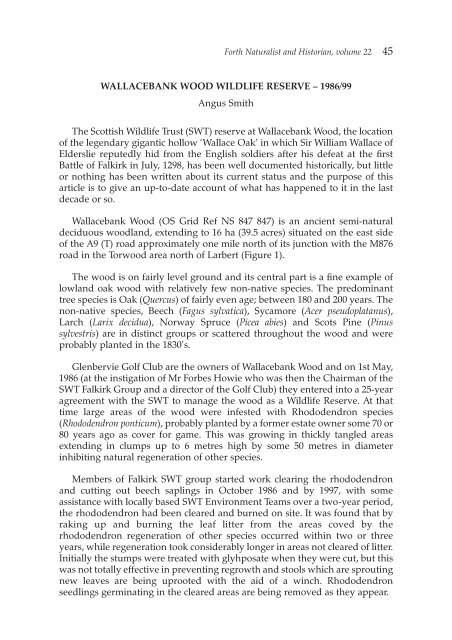the Forth Naturalist Historian - Forth Naturalist and Historian ...
the Forth Naturalist Historian - Forth Naturalist and Historian ...
the Forth Naturalist Historian - Forth Naturalist and Historian ...
Create successful ePaper yourself
Turn your PDF publications into a flip-book with our unique Google optimized e-Paper software.
<strong>Forth</strong> <strong>Naturalist</strong> <strong>and</strong> <strong>Historian</strong>, volume 22 45<br />
WALLACEBANK WOOD WILDLIFE RESERVE – 1986/99<br />
Angus Smith<br />
The Scottish Wildlife Trust (SWT) reserve at Wallacebank Wood, <strong>the</strong> location<br />
of <strong>the</strong> legendary gigantic hollow ‘Wallace Oak’ in which Sir William Wallace of<br />
Elderslie reputedly hid from <strong>the</strong> English soldiers after his defeat at <strong>the</strong> first<br />
Battle of Falkirk in July, 1298, has been well documented historically, but little<br />
or nothing has been written about its current status <strong>and</strong> <strong>the</strong> purpose of this<br />
article is to give an up-to-date account of what has happened to it in <strong>the</strong> last<br />
decade or so.<br />
Wallacebank Wood (OS Grid Ref NS 847 847) is an ancient semi-natural<br />
deciduous woodl<strong>and</strong>, extending to 16 ha (39.5 acres) situated on <strong>the</strong> east side<br />
of <strong>the</strong> A9 (T) road approximately one mile north of its junction with <strong>the</strong> M876<br />
road in <strong>the</strong> Torwood area north of Larbert (Figure 1).<br />
The wood is on fairly level ground <strong>and</strong> its central part is a fine example of<br />
lowl<strong>and</strong> oak wood with relatively few non-native species. The predominant<br />
tree species is Oak (Quercus) of fairly even age; between 180 <strong>and</strong> 200 years. The<br />
non-native species, Beech (Fagus sylvatica), Sycamore (Acer pseudoplatanus),<br />
Larch (Larix decidua), Norway Spruce (Picea abies) <strong>and</strong> Scots Pine (Pinus<br />
sylvestris) are in distinct groups or scattered throughout <strong>the</strong> wood <strong>and</strong> were<br />
probably planted in <strong>the</strong> 1830’s.<br />
Glenbervie Golf Club are <strong>the</strong> owners of Wallacebank Wood <strong>and</strong> on 1st May,<br />
1986 (at <strong>the</strong> instigation of Mr Forbes Howie who was <strong>the</strong>n <strong>the</strong> Chairman of <strong>the</strong><br />
SWT Falkirk Group <strong>and</strong> a director of <strong>the</strong> Golf Club) <strong>the</strong>y entered into a 25-year<br />
agreement with <strong>the</strong> SWT to manage <strong>the</strong> wood as a Wildlife Reserve. At that<br />
time large areas of <strong>the</strong> wood were infested with Rhododendron species<br />
(Rhododendron ponticum), probably planted by a former estate owner some 70 or<br />
80 years ago as cover for game. This was growing in thickly tangled areas<br />
extending in clumps up to 6 metres high by some 50 metres in diameter<br />
inhibiting natural regeneration of o<strong>the</strong>r species.<br />
Members of Falkirk SWT group started work clearing <strong>the</strong> rhododendron<br />
<strong>and</strong> cutting out beech saplings in October 1986 <strong>and</strong> by 1997, with some<br />
assistance with locally based SWT Environment Teams over a two-year period,<br />
<strong>the</strong> rhododendron had been cleared <strong>and</strong> burned on site. It was found that by<br />
raking up <strong>and</strong> burning <strong>the</strong> leaf litter from <strong>the</strong> areas coved by <strong>the</strong><br />
rhododendron regeneration of o<strong>the</strong>r species occurred within two or three<br />
years, while regeneration took considerably longer in areas not cleared of litter.<br />
Initially <strong>the</strong> stumps were treated with glyhposate when <strong>the</strong>y were cut, but this<br />
was not totally effective in preventing regrowth <strong>and</strong> stools which are sprouting<br />
new leaves are being uprooted with <strong>the</strong> aid of a winch. Rhododendron<br />
seedlings germinating in <strong>the</strong> cleared areas are being removed as <strong>the</strong>y appear.



